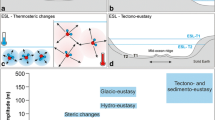Abstract
We selected surface flux datasets to investigate the heat fluxes during “hot events”; (HEs), defined as short-term, large-scale phenomena involving very high sea surface temperature (SST). Validation of the heat fluxes against in-situ ones, which are estimated from in-situ observation in HE sampling conditions, shows the accuracies (bias ± RMS error) of net shortwave radiation, net long wave radiation, latent heat and sensible heat fluxes are 20 ± 45.0 W m−2, −9 ± 12.3 W m−2, −2.3 ± 31.5 W m−2 and 1.5 ± 5.0 W m−2, respectively. Statistical analyses of HEs show that, during these events, net solar radiation remains high and then decreases from 246 to 220 W m−2, while latent heat is low and then increases from 100 W m−2 to 124 W m−2. Histogram peaks indicate net solar radiation of 270 W m−2 and latent heat flux of 90 W m−2 during HEs. Further, HEs are shown to evolve in three phases: formation, mature, and ending phases. Mean heat gain (HG) in the HE formation phase of 60 W m−2 is larger than the reasonably estimated annual mean HG range of 0–25 W m−2 in the Indo-Pacific Warm Pool. Such large daily HG in the HE formation phase can be expected to increase SSTs and produce large amplitudes of diurnal SST variations during HEs, which have been observed by both satellite and in-situ measurements in our previous studies.
Similar content being viewed by others
References
Bradley, E. F., J. S. Godfrey, P. A. Coppin and J. A. Butt (1993): Observations of net heat flux into the surface mixed layer of the western equatorial Pacific Ocean. J. Geophys. Res., 98(C12), 22,521–22,532.
Cronin, M. F. and M. J. McPhaden (1997): The upper ocean heat balance in the western equatorial Pacific warm pool during September–December 1992. J. Geophys. Res., 102(C4), 8533–8553.
Da Silva, A. M., C. C. Young and S. Levitus (1994): Atlas of surface marine data, 1994. Vol. 1; Algorithms and procedures. NOAA Atlas NESDIS 6, U.S. Dept. of Commerce, 83 pp.
Fairall, C. W., E. F. Bradley, J. E. Hare, A. A. Grachev and J. B. Edson (2003): Bulk parameterization of air-sea fluxes: Updates and verification for the COARE algorithm. J. Climate, 16, 571–591.
Fasullo, J. and P. J. Webster (1999): Warm pool SST variability in relation to the surface energy balance. J. Climate, 12 1292–1304.
Gent, P. R. (1991): The heat budget of the TOGA-COARE domain in an ocean model. J. Geophys. Res., 96(Supplement), 3323–3330.
Godfrey, J. S. and E. J. Lindstrom (1989): The heat budget of the equatorial western Pacific surface mixed layer. J. Geophys. Res., 94(C6), 8007–8017.
Godfrey, J. S., M. Nunez, E. F. Bradley, P. A. Coppin and E. J. Lindstrom (1991): On the net surface heat flux into the western equatorial Pacific. J. Geophys. Res., 96(Supplement), 3391–3400.
Graham, N. E. and T. P. Barnett (1987): Sea surface temperature, surface wind divergence, and convection over the tropical oceans. Science, 238, 657–659.
Hallberg, R. and A. K. Inamdar (1993): Observations of seasonal variations in atmospheric greenhouse trapping and its enhancement at high sea surface temperature. J. Climate, 6, 920–931.
Hsuing, J. (1985): Estimates of global oceanic meridional heat transport. J. Phys. Oceanogr., 15, 1405–1413.
Kalnay, E. et al. (1996): The NCEP-NCAR 40 year reanalysis project. Bull. Amer. Meteorol. Soc., 77, 437–471.
Kawai, Y., H. Kawamura, S. Takahashi, K. Hosoda, H. Murakami, M. Kachi and L. Guan (2006): Satellite-based high-resolution global optimum interpolation sea surface temperature data. J. Geophys. Res., 111, C06016, doi:10.1029/2005JC003313.
Kawamura, H., H. Qin and K. Ando (2008): In-situ diurnal sea surface temperature variations and near-surface thermal structure in the tropical hot event of the Indo-Pacific warm pool. J. Oceanogr., 64, 847–857.
Onogi, K. et al. (2006): JRA-25: Japanese 25-year re-analysis. Q. J. R. Meteorol. Soc., 131, 3259–3268.
Qin, H., H. Kawamura and Y. Kawai (2007): Detection of hot event in the equatorial Indo-Pacific warm pool using advanced satellite sea surface temperature, solar radiation, and wind speed. J. Geophys. Res.-Ocean, 112, C07015, doi:10.1029/2006JC003969.
Qin, H., H. Kawamura, F. Sakaida and K. Ando (2008): A case study of the tropical Hot Event in November 2006 (HE0611) using a geostationary meteorological satellite and the TAO/TRITON mooring array. J. Geophys. Res.-Ocean, 113, C08045, doi:10.1029/2007JC004640.
Reed, R. K. (1985): An estimate of the climatological heat fluxes over the tropical Pacific Ocean. J. Climate Appl. Meteor., 24, 833–840.
Reynolds, R. W. and T. M. Smith (1994): Improved global sea surface temperature analyses using optimum interpolation. J. Climate, 7, 929–948.
Schiffer, R. A. and W. B. Rossow (1985): ISCCP global radiance data set: A new resource for climate research. Bull. Amer. Meteorol. Soc., 66, 1498–1505, doi:10.1175/1520-0477.
Shinoda, T., H. H. Hendon and J. D. Glick (1998): Intraseasonal variability of surface fluxes and sea surface temperature in the tropical western Pacific and Indian Oceans. J. Climate, 7, 1685–1702.
Tompkins, A. M. (2001): On the relationship between tropical convection and sea surface temperature. J. Climate, 14, 633–637.
Waliser, D. E. (1996): Formation and limiting mechanisms for very high sea surface temperature: Linking the dynamics and the thermodynamics. J. Climate, 9, 161–187.
Wang, W. and M. J. McPhaden (2000): The surface layer heat balance in the equatorial Pacific ocean. Part II: Interannual variability. J. Phys. Oceanogr., 30, 2989–3008.
Weare, B. C., P. T. Strub and M. D. Samuel (1981): Annual mean surface heat flux in the tropical ocean. J. Phys. Oceanogr., 11, 705–711.
Yu, L., X. Jin and R. A. Weller (2008): Multidecade global flux datasets from the Objectively Analyzed Air-sea Fluxes (OAFlux) project: Latent and sensible heat fluxes, ocean evaporation, and related surface meteorological variables. Woods Hole Oceanographic Institution, OAFlux Project Technical Report, OA-2008-01, 64 pp., Woods Hole, Massachusetts.
Author information
Authors and Affiliations
Corresponding author
Rights and permissions
About this article
Cite this article
Qin, H., Kawamura, H. Surface heat fluxes during hot events. J Oceanogr 65, 605–613 (2009). https://doi.org/10.1007/s10872-009-0051-7
Received:
Revised:
Accepted:
Published:
Issue Date:
DOI: https://doi.org/10.1007/s10872-009-0051-7




